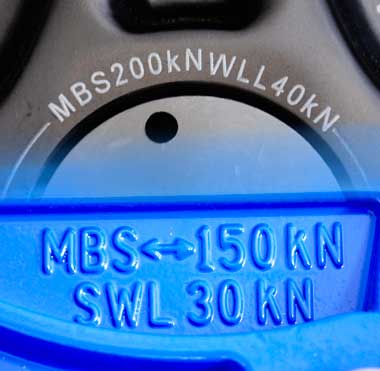Quality arborist blocks have the Minimum Break Strength (MBS) and Safe Working Load (SWL) or Working Load Limit (WLL) clearly visible to the user. The SWL or WLL figure for rigging hardware is typically based on a 5:1 safety factor relative to the MBS.
But the SWL or WLL on the block is not the figure you should be using for load application.
The more important number to consider is the breaking or tensile strength of your rigging rope.
The NZ Arbor BPG (Best Practice Guideline) states: the SWL (should be) 10% of the average breaking strength or tensile strength of the rope, unless otherwise stated by the manufacturer - this means you apply a safety factor of 10:1.
For example, a rigging line with an tensile strength of 6000kg has a WLL of 600kg if you apply the 10:1 ratio (divide 6000 by 10 or simply drop the last zero). To be on the safe side, some say you could half this figure again to allow for rope wear and knots.
Obviously 600kg is a long way shy of the figure stated on the block but, when rigging, the critical factor to consider is the load capacity of the rope, since the rigging line should be the weakest link in the chain.
Therefore it's the 10:1 SWL or WLL of the rigging rope you should be working to, not the 5:1 SWL of WLL indicated on the block!

